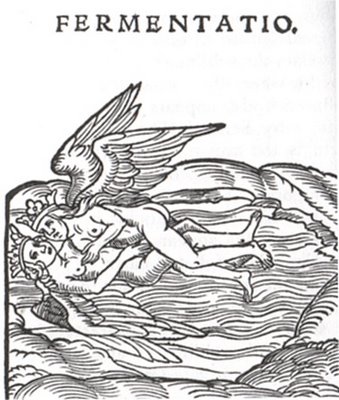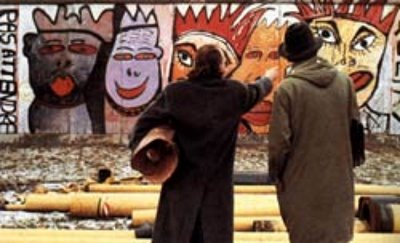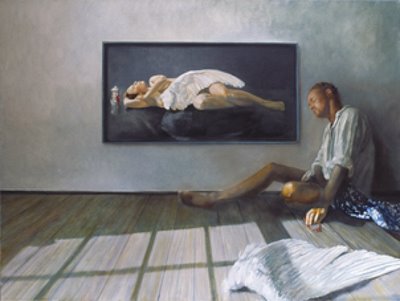Chapter 10: Finale; References
Many artists end their series on Cupid and Psyche with a banquet. For Klinger, it is a wedding feast, with after-dinner entertainment (10a).

I invite the reader to find Psyche and Cupid above, and identify some of the other gods that are present. In this close-up of the gods, I have cropped the picture so that the viewer cannot see what they are watching. In the whole engraving (10b), it becomes obvious:

Venus is doing a dance, as Apuleius himself relates, thus giving her implicit approval to the union.
For other artists, such as Giulio Romano, there is simply a “banquet of the gods,” not a wedding banquet as such, because there is now a child, the daughter of Cupid and Psyche (10c). The child between Psyche and Cupid is named, Apuleius tells us, Joy, Voluptas in Latin (10d, detail of 10c). Since all are naked, this child will not have to wonder what the phallus looks like, unconsciously giving it a supernatural aura.


Alchemically this scene, the parents lying together naked with the child, corresponds to two steps in the Rosarium serie. First is a stage of closeness between the pair without intercourse, the fermentatio (10e, Emblem 11 of the Rosarium). Note that the pair both have wings now; they are uplifted.

After that comes the illuminatio (10f), a hermaphroditic face with wings descending into the chaos, according to the attached verse. Illuminations require long preparations but then are all too brief in this life.

Only at the end of the series is there anything more permanent, the coronation of the virgin, emblem 19, and Christ emerging from the tomb, the 20th and final emblem (as standard religious images, neither is reproduced here).
Joy, the child of Cupid and Psyche, is usually interpreted as the joy of unity with the divine, although the word, in English as well as the Latin Voluptas, has other connotations. No doubt some ambiguity is intended.
The alchemist’s title Illuminatio shows his affinity with Gnosticism: what is desired is an experience of the divine (divinity connoted by the wings), however brief.
In "Wings of Desire," in contrast, the former angel, now wingless, walks in his new world of color, one full of little joys that Peter Falk, a kind of Vergil to Ganz’s Date, points out to him, such as the paintings that enliven the Berlin Wall (10g).

In von Gierke’s final paintings in his post-modern series, done almost 20 years after Wenders’ film, the meaning is more enigmatic. In the first, the man sits by his painting. Is this Cupid with Psyche? We could perhaps say that his idea has achieved its immortality in his painting, and now the job is done (10h).

Von Gierke calls this painting “Harmonie/Weiss.” “Harmony” of course is Harmony. “Weiss” has several meanings: white, blank, and also the first and third person singular of the verb “to know.” “Harmony” von Gierke’s version of Voluptas, Joy? Yet Harmony appears elusive here. The painter seems a bit sad. “Know” and “White,” however, are pretty close to “Illuminatio.”
What is more, the job is not done. There are two more paintings. In the first, someone reaches for the vessel, like Psyche reaching either for the beauty box or, fitting better at this point, the ambrosia (10i, entitled “Spiegelung”, Reflection).

Finally, not only have the models been dismissed, but the paintings have been removed from the walls. There remain magical tokens of something having been, and a sense of mystery (slide 10j, entitled “Interieur/Fleugel”: Interior, Wing).

Our tale is done, but the story does not end here. In Apuleius, the tale is imbedded in a larger story. The protagonist, one Lucius (i.e. Light), gets turned into an ass while dabbling in magic. He is then taken by robbers, who use him to haul their loot. In the robbbers’ cave, while they are out, their old servant woman tells the tale of Psyche and Cupid to another captive, the girl Charite (one of the names of Sophia in Gnosticism), while Lucius listens. The robbers had taken Charite on her wedding day in hopes of ransom. Perhaps inspired by Psyche’s example, Lucius later takes the opportunity to escape, and Cherite jumps on his back. Both have their own trials after that. Charite returns to find her husband murdered; rather like Shakespere’s Hamlet, she gets visit from his ghost and the task of vengeance. Lucius, eventually desperate to stop life in the form of an ass, receives a vision from the goddess Isis. She advises him to eat the flower of the wild rose, the plant sacred to her. That works, and from then on he devotes himself to her cult and that of her husband Osiris. He also develops a career in the law. He is no longer the flighty youth he was before. By implication, the reader is exhorted to follow the examples of Psyche, Charite, and Lucius, in courage and devotion to Truth.
In our own day, Truth is more elusive than it was seen to be in former times. Yet the lesson remains, to face our fears and demons as Psyche did in response to her tasks, listening to our authentic spirit and thereby aiding the purification and reunion of our own inner masculine and feminine sides.
For another interpretation of the tale of Cupid and Psyche, this time in terms of the 22 major arcana of the tarot, see my blog post at http://dionysisandtarot.blogspot.com/2012/04/blank_8209.html
References
(A) Artists, by period, in roughly the order of their first appearance in the slide show.
Renaissance. (1) Jacopo del Sallaio, pupil of Botticelli, wedding chest, Florence 1490’s. (2) Perin del Vaga, pupil of Raphael, for apartments of Pope Paul III, Rome, and for Andrea Dorea, Genoa, 1520’s-30’s. (3) Raphael and assistants, Villa Farnesina, Rome, 1518. (4) Giulio Romano, pupil of Raphael, Palazzo Te, Mantua, ca. 1525. (5) Stained glass windows, Ecouen Castle, near Paris, 1540’s, artist unknown. (6) Bartholomaeus Spranger, ca. 1600 for Rudolph II in Prague. (7) Masaccio, Adam and Eve, Florence. (8) Baroque painter: Anthony van Dyke, Flemish, 1638.
Neoclassical. (1) Pierre-Paul Prudhon, 1808, Paris, Psyche Borne by Zephyrs. (2) Francois Gerard, first kiss, 1798, Paris. (3) Jacques-Louis David, Cupid leaving sleeping Psyche, 1817, Paris. (4) Francois-Edouard Picot, same subject, 1817. (5) Pietro Tenarani, Psyche Abandoned, sculpture, 1816-1817, Florence. (6) George Romney, engravings, ca. 1777, London. (7) Johann Heinrich Mayer, above-door painting, 1795, Germany. (8) Antonio Canova, kiss, 1793, Paris. (9) Herman Vilhelm Bissen, Cupid and Psyche in heaven, 1807, Copenhagen.
Art Nouveau. (1) Maurice Denis, sketch, 1908, Paris. (2) Edward Burne-Jones, watercolors and engravings 1865-1870, paintings 1872-1881, London. (3) Max Klinger, 1880, Germany. (4) John William Waterhouse, 1903-1904, London (5) Adolphe William Bouguereau, 1895-1899, Paris.
Post-World War II: (1) Basil Rakopzi, 1949. (2) Edward Durat, 1951.
Since 1985. (1) “Perifimou” (Alexander Georgiou), 1988. (2) Wim Wenders, 1987. (3) Hemming von Gierke, 2005. (4) Frances Luke, ca 2005. (5) Wendy W. Lee 1997. (6) Carla Spandafori 2003. (7) Jacqueline Morreau 1986-1993. (8) Lon Holdread, 2004. (9) RPG Expert, 2004 (rpgexpert.com). (10) Erica Ronnback, ca 2005.
(B) Other references.
Images from Renaissance Books: (1) Alchemical illustrations: from Quinta Essentia, Leipzig 1579; Rosarium Philosophorum, Frankfort 1558; Atalanta Fugiens, 1618, Philosophophia Reformata, Frankfort 1622. (2) Metallurgical illustration: from Georgius Agricola, i, 1556.
Modern Print References, as sources of images: The Tale of Cupid and Psyche, An illustrated History, by S. Cavicchioli. I took all of the images about Cupid and Psyche from before 1905 from this source except 1b, 1f, 6t, 8g, 8h, 8k, 8q, and 9e. These and the rest come from the World Wide Web, for which see below. The alchemical images and quotes are in Alchemy, by J. Fabricius. 8i is in numerous books on early publishing, Renaissance emblems, or Erasmus, who used the Aldus Press.
Jungian references: Mysterium Coniunctionis and Alchemical Studies, by C.G. Jung; She, by R. Johnson, Amor and Psyche, by E. Neumann, and An Interpretation of Apuleius’ Golden Ass, by M.-L. von Franz.
World Wide Web, as a source for images used: (1) Google Images with keyword “Psyche.” (2) “Images of Cupid and Psyche” at www.scils.rutgers.edu/~mjoseph/CP/ICP.html; (3) the official website for “Wings of Desire.”

I invite the reader to find Psyche and Cupid above, and identify some of the other gods that are present. In this close-up of the gods, I have cropped the picture so that the viewer cannot see what they are watching. In the whole engraving (10b), it becomes obvious:

Venus is doing a dance, as Apuleius himself relates, thus giving her implicit approval to the union.
For other artists, such as Giulio Romano, there is simply a “banquet of the gods,” not a wedding banquet as such, because there is now a child, the daughter of Cupid and Psyche (10c). The child between Psyche and Cupid is named, Apuleius tells us, Joy, Voluptas in Latin (10d, detail of 10c). Since all are naked, this child will not have to wonder what the phallus looks like, unconsciously giving it a supernatural aura.


Alchemically this scene, the parents lying together naked with the child, corresponds to two steps in the Rosarium serie. First is a stage of closeness between the pair without intercourse, the fermentatio (10e, Emblem 11 of the Rosarium). Note that the pair both have wings now; they are uplifted.

After that comes the illuminatio (10f), a hermaphroditic face with wings descending into the chaos, according to the attached verse. Illuminations require long preparations but then are all too brief in this life.

Only at the end of the series is there anything more permanent, the coronation of the virgin, emblem 19, and Christ emerging from the tomb, the 20th and final emblem (as standard religious images, neither is reproduced here).
Joy, the child of Cupid and Psyche, is usually interpreted as the joy of unity with the divine, although the word, in English as well as the Latin Voluptas, has other connotations. No doubt some ambiguity is intended.
The alchemist’s title Illuminatio shows his affinity with Gnosticism: what is desired is an experience of the divine (divinity connoted by the wings), however brief.
In "Wings of Desire," in contrast, the former angel, now wingless, walks in his new world of color, one full of little joys that Peter Falk, a kind of Vergil to Ganz’s Date, points out to him, such as the paintings that enliven the Berlin Wall (10g).

In von Gierke’s final paintings in his post-modern series, done almost 20 years after Wenders’ film, the meaning is more enigmatic. In the first, the man sits by his painting. Is this Cupid with Psyche? We could perhaps say that his idea has achieved its immortality in his painting, and now the job is done (10h).

Von Gierke calls this painting “Harmonie/Weiss.” “Harmony” of course is Harmony. “Weiss” has several meanings: white, blank, and also the first and third person singular of the verb “to know.” “Harmony” von Gierke’s version of Voluptas, Joy? Yet Harmony appears elusive here. The painter seems a bit sad. “Know” and “White,” however, are pretty close to “Illuminatio.”
What is more, the job is not done. There are two more paintings. In the first, someone reaches for the vessel, like Psyche reaching either for the beauty box or, fitting better at this point, the ambrosia (10i, entitled “Spiegelung”, Reflection).

Finally, not only have the models been dismissed, but the paintings have been removed from the walls. There remain magical tokens of something having been, and a sense of mystery (slide 10j, entitled “Interieur/Fleugel”: Interior, Wing).

Our tale is done, but the story does not end here. In Apuleius, the tale is imbedded in a larger story. The protagonist, one Lucius (i.e. Light), gets turned into an ass while dabbling in magic. He is then taken by robbers, who use him to haul their loot. In the robbbers’ cave, while they are out, their old servant woman tells the tale of Psyche and Cupid to another captive, the girl Charite (one of the names of Sophia in Gnosticism), while Lucius listens. The robbers had taken Charite on her wedding day in hopes of ransom. Perhaps inspired by Psyche’s example, Lucius later takes the opportunity to escape, and Cherite jumps on his back. Both have their own trials after that. Charite returns to find her husband murdered; rather like Shakespere’s Hamlet, she gets visit from his ghost and the task of vengeance. Lucius, eventually desperate to stop life in the form of an ass, receives a vision from the goddess Isis. She advises him to eat the flower of the wild rose, the plant sacred to her. That works, and from then on he devotes himself to her cult and that of her husband Osiris. He also develops a career in the law. He is no longer the flighty youth he was before. By implication, the reader is exhorted to follow the examples of Psyche, Charite, and Lucius, in courage and devotion to Truth.
In our own day, Truth is more elusive than it was seen to be in former times. Yet the lesson remains, to face our fears and demons as Psyche did in response to her tasks, listening to our authentic spirit and thereby aiding the purification and reunion of our own inner masculine and feminine sides.
For another interpretation of the tale of Cupid and Psyche, this time in terms of the 22 major arcana of the tarot, see my blog post at http://dionysisandtarot.blogspot.com/2012/04/blank_8209.html
References
(A) Artists, by period, in roughly the order of their first appearance in the slide show.
Renaissance. (1) Jacopo del Sallaio, pupil of Botticelli, wedding chest, Florence 1490’s. (2) Perin del Vaga, pupil of Raphael, for apartments of Pope Paul III, Rome, and for Andrea Dorea, Genoa, 1520’s-30’s. (3) Raphael and assistants, Villa Farnesina, Rome, 1518. (4) Giulio Romano, pupil of Raphael, Palazzo Te, Mantua, ca. 1525. (5) Stained glass windows, Ecouen Castle, near Paris, 1540’s, artist unknown. (6) Bartholomaeus Spranger, ca. 1600 for Rudolph II in Prague. (7) Masaccio, Adam and Eve, Florence. (8) Baroque painter: Anthony van Dyke, Flemish, 1638.
Neoclassical. (1) Pierre-Paul Prudhon, 1808, Paris, Psyche Borne by Zephyrs. (2) Francois Gerard, first kiss, 1798, Paris. (3) Jacques-Louis David, Cupid leaving sleeping Psyche, 1817, Paris. (4) Francois-Edouard Picot, same subject, 1817. (5) Pietro Tenarani, Psyche Abandoned, sculpture, 1816-1817, Florence. (6) George Romney, engravings, ca. 1777, London. (7) Johann Heinrich Mayer, above-door painting, 1795, Germany. (8) Antonio Canova, kiss, 1793, Paris. (9) Herman Vilhelm Bissen, Cupid and Psyche in heaven, 1807, Copenhagen.
Art Nouveau. (1) Maurice Denis, sketch, 1908, Paris. (2) Edward Burne-Jones, watercolors and engravings 1865-1870, paintings 1872-1881, London. (3) Max Klinger, 1880, Germany. (4) John William Waterhouse, 1903-1904, London (5) Adolphe William Bouguereau, 1895-1899, Paris.
Post-World War II: (1) Basil Rakopzi, 1949. (2) Edward Durat, 1951.
Since 1985. (1) “Perifimou” (Alexander Georgiou), 1988. (2) Wim Wenders, 1987. (3) Hemming von Gierke, 2005. (4) Frances Luke, ca 2005. (5) Wendy W. Lee 1997. (6) Carla Spandafori 2003. (7) Jacqueline Morreau 1986-1993. (8) Lon Holdread, 2004. (9) RPG Expert, 2004 (rpgexpert.com). (10) Erica Ronnback, ca 2005.
(B) Other references.
Images from Renaissance Books: (1) Alchemical illustrations: from Quinta Essentia, Leipzig 1579; Rosarium Philosophorum, Frankfort 1558; Atalanta Fugiens, 1618, Philosophophia Reformata, Frankfort 1622. (2) Metallurgical illustration: from Georgius Agricola, i, 1556.
Modern Print References, as sources of images: The Tale of Cupid and Psyche, An illustrated History, by S. Cavicchioli. I took all of the images about Cupid and Psyche from before 1905 from this source except 1b, 1f, 6t, 8g, 8h, 8k, 8q, and 9e. These and the rest come from the World Wide Web, for which see below. The alchemical images and quotes are in Alchemy, by J. Fabricius. 8i is in numerous books on early publishing, Renaissance emblems, or Erasmus, who used the Aldus Press.
Jungian references: Mysterium Coniunctionis and Alchemical Studies, by C.G. Jung; She, by R. Johnson, Amor and Psyche, by E. Neumann, and An Interpretation of Apuleius’ Golden Ass, by M.-L. von Franz.
World Wide Web, as a source for images used: (1) Google Images with keyword “Psyche.” (2) “Images of Cupid and Psyche” at www.scils.rutgers.edu/~mjoseph/CP/ICP.html; (3) the official website for “Wings of Desire.”

0 Comments:
Post a Comment
<< Home